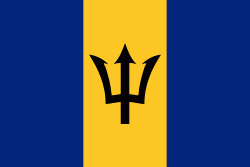Crab Hill (Crab Hill)
Crab Hill is a settlement in Barbados, at the northern end of the parish of Saint Lucy. The place was so named because large numbers of crabs would appear in the area during rainfall; people would catch the crabs and keep them as pets. The population is 727 (2018), which makes it the most populous place in the parish of St. Lucy. Crab Hill is the site of the St. Lucy Police Station. The Mount Gay North Stars Cricket Ground is located in Crab Hill.
Map - Crab Hill (Crab Hill)
Map
Country - Barbados
 |
 |
| Flag of Barbados | |
Inhabited by Kalinago people since the 13th century, and prior to that by other Amerindians, Spanish navigators took possession of Barbados in the late 15th century, claiming it for the Crown of Castile. It first appeared on a Spanish map in 1511. The Portuguese Empire claimed the island between 1532 and 1536, but abandoned it in 1620 with their only remnants being an introduction of wild boars for a good supply of meat whenever the island was visited. An English ship, the Olive Blossom, arrived in Barbados on 14 May 1625; its men took possession of the island in the name of King James I. In 1627, the first permanent settlers arrived from England, and Barbados became an English and later British colony. During this period, the colony operated on a plantation economy, relying on the labour of African slaves who worked on the island's plantations. Slavery continued until it was phased out through most of the British Empire by the Slavery Abolition Act 1833.
Currency / Language
| ISO | Currency | Symbol | Significant figures |
|---|---|---|---|
| BBD | Barbados dollar | $ | 2 |
| USD | United States dollar | $ | 2 |
| ISO | Language |
|---|---|
| EN | English language |















